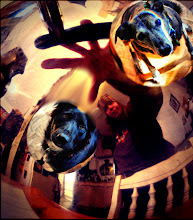
The rock was unhappy. I could tell. Don’t ask me how, I just could. It was an ordinary rock, neither attractive nor repellent in shape or color. Just a rock.
I found it on one of my daily rock hunts in a field next to the railroad tracks. For several months I went there with my collie. He got to run around and chase the Frisbee and pee on all things vertical.
I found a lot of nice rocks in that field. I displayed them in bowls and on shelves. People were amazed that there were so many different kinds from such a small field in the middle of town. It was the railroad, of course. They brought rock in from all over to fill the spaces between the wooden ties that the rails rested on.
There were smooth round and egg-shaped granite stones that fit in the palm of your hand. Their contours suggestive of years spent rolling among others like them in swiftly flowing water.
Some had gleaming flat planes of white or pink that threw back the sun in blinding flashes. Their lines were square or oblong, fractures that bespoke violent impacts from falls or blasting.
There was sandstone, chertz, conglomerate and many more I did not know the names of. Many were beautiful - but not the ordinary rock. It was brownish-gray, and irregular in shape – not smooth or jagged. It was just a rock, like one you would snatch up to fling at a stray dog who offered to bite. But I noticed it. I felt its distress. It wasn’t that it spoke to me, it just radiated unhappiness.
The rock had an ugly smear of oil on it. This was not surprising, there were a great many rocks – the ones close to the rails - that were coated with a film of oily dirt. They merged together in a mass of undifferentiated grubbiness. You didn’t notice them. Your eye would pass over their soiled huddle, not seeing individual stones. Perhaps they were resigned to their collective, dirty anonymity.
But the unhappy stone was different. It lay a good 25 feet from the tracks. The oily smear on it was a diagonal obscenity and the rock detested it. I knew this, so I took it home to clean it.
As I walked home with my pockets full of stones, my dog pacing contentedly at my side, I wondered why this rock had "spoken" to me. I had long ago decided that human beings were not the only things on earth in possession of a soul. Animals had them too, and later I decided that trees, rocks and even machines had some spark of consciousness about them. I never talked much about it. It’s the sort of notion that makes psychiatrists knit their brows and scribble notes in your file – the sort of thing that makes your friends fall silent and then say, “That’s interesting…”
I remembered reading a book about kimonos. It was filled with gorgeous pictures of antique creations that were rare works of art. It explained that they were made from strips of cloth loomed in pieces of the length needed for each part, and then sewn together. The kimono pieces were not cut from a long bolt of cloth like western garments. They were a joined collection of whole pieces, as it were, a community of fabric entities. This was done to honor the souls of the separate components of the garment. When the kimono became soiled the seams were picked out, the pieces were washed, and then the garment was reassembled. And the garment was respected as an entity with a sort of soul – a spirit, if you like.
This was described as one of the tenets of the Shinto faith. This assumption that all animate creatures and many things thought by some to be inanimate were possessed of a “kami,” or spirit.
This description struck a chord in me. I was deeply impressed by its “rightness.” Why do people give names to boats and airplanes – cars, even. Because they exist in a way that we relate to. They have quirks. Personalities. Different from ours, but no less real or valid for all that.
Anyway, the rock was unhappy. So I took it home and spent several hours removing the ugly oil stain. It wasn’t easy. I tried detergent, nail-polish remover, alcohol, and gasoline. I soaked it in solutions of enzymes and used mechanic’s hand cleaner on it. It took a long time and a lot of scrubbing.
At last the stain was gone. As I finished the cleaning, my neighbor who had come over for a visit, asked me what I intended to do with the rock I had labored over so industriously. Was it to be part of a “found object” art project or accorded a special place in my collection of rocks?
“No,” I said. “I’m gonna take it over tomorrow and pitch it back into the field.”
My friend was taken aback by this. But I didn’t mind. The rock wasn’t unhappy any more. It could go home and get on with its life, such as it was. That was what mattered to me.


No comments:
Post a Comment